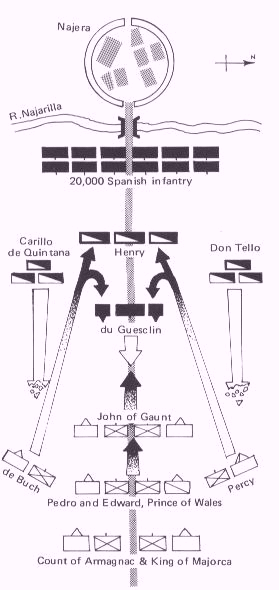
Consequences of the battle
More information at:
Battle of Najera at The Hundred Years War.
Why the Prince of Wales waged War on Henry of Trastamara, by Jean Froissart.
Also, from British-History.com
At Najera, unlike all previous battles, it was the English who attacked the dismounted French and Spanish troops. The vanguard of the English was led by Sir John Chandos, Constable of Aquitaine, with Duke John of Gaunt at his side. They attacked the French mercenary contingents in the central battle, commanded by du Guesclin and d'Audrehem, the English men-at-arm advancing under a heavy covering fire from their archers. The French held his advance until the Prince, recalling Poitiers, came up in close support with his dismounted main battle.
The Spanish troops supporting the French fled, leaving Henry of Trastamara's main battle fully exposed to the archers and a thunderous attack by the mounted rearguard of the Prince's army, led by Sir Hugh Calveley and the Count of Armagnac. Half Henry's force having fled the field without striking a blow, the Franco-Castilian army disintegrated and the rout, closely pursed by the English, rolled back to the banks of the river Najerilla, where there was slaughter. The waters below the only bridge were choked with bodies, and the dead pilled up along the streets of the town.
By mid-afternoon the battle was over, and the English had time to count their prisoners. Henry of Trastamara had escaped, but many knights, including the Masters of the great Military orders of Santiago and Calatrava, plus Bertrand du Gueclin and Marshal d'Audrehem were in Anglo-Gascon hands. The prince had great trouble preventing Pedro the Cruel from executing the prisoners out of hand, while the Prince himself threatened to execute Marshal d'Audreham, who had still not paid his ransom due after his capture at Poitiers and should not have taken up arms against the prince until this debt had been discharged. D'Audrehem avoided this fate by pointing out rather bluntly in the circumstances that he was not fighting against the Prince of Wales but against the Prince's paymaster, Pedro the Cruel.